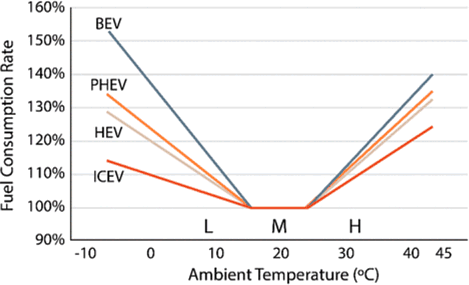MIT study compares emission benefits of electrified and lightweighted vehicles
28 August 2019
A number of policies to encourage reductions in GHG emissions stress the need to switch as many vehicles as possible to electric power. But a new study by MIT and the Ford Motor Company [4445] found that depending on the location, in some cases an equivalent or even bigger reduction in emissions could be achieved by switching to lightweight conventional (gasoline powered) vehicles instead.
The study looked at several factors that can affect the relative performance of these vehicles, including the role of low temperatures in reducing battery performance, regional differences in average number of miles driven annually, and the different mix of generating sources in different parts of the United States.
The study combined a variety of datasets to examine the relative impact of different vehicle choices. It showed that while electric vehicles provide the greatest impact in reducing GHG emissions for most of the country, especially on both coasts and in the south, significant parts of the Midwest had the opposite result, with lightweight gasoline-powered vehicles achieving a greater reduction.
The biggest factor affecting emissions was the mix of generating sources going into the grid in different regions. That mix is “cleaner” on both the East and West coasts, with higher usage of renewable energy sources and relatively low-emissions natural gas, while in the upper Midwest there is still a much higher proportion of coal-burning power plants. In those locations, buying a lightweight car, defined as one whose structure is built largely from aluminum or specialized lightweight steel, would actually result in fewer emissions than buying a comparable electric car, the study found.
The research was made possible by Ford’s collection of vehicle-performance data from about 30,000 cars, over a total of about 300 million miles of driving. They come from conventional midsize conventional gasoline cars, and the researchers used standard modeling techniques to calculate the performance of equivalent vehicles that were either hybrid-electric, battery-electric, or lightweight versions of conventional cars.
To analyze the combined effects of the various factors of temperature, the grid, and driving conditions, the researchers developed a novel adjustment model to estimate the effects of temperature on fuel economy for four powertrain types—ICEV, HEV, PHEV, and BEV—based on meta-analysis of three previous studies and one empirical database, Figure 1.

100% is indexed to the baseline fuel consumption rate for each powertrain
The combination of data showed that some of the areas with more carbon-heavy grids also happened to be colder, and somewhat more rural. All three of those things can tilt emissions in a negative way for electric vehicles. The combined effects are strongest in parts of Wisconsin and Michigan, where lightweight cars would have a significant advantage over EVs in reducing emissions, the study showed. Conversely, gasoline-powered vehicles suffer an efficiency penalty in urban driving, but they have lower emissions in regions that are more rural and spread out.
Lightweight aluminum is now used in the Ford F-150 pickup truck, and in the all-electric Tesla sedans. Currently, there are no high-volume lightweight gasoline-powered midsize cars on the US market.
Source: MIT News